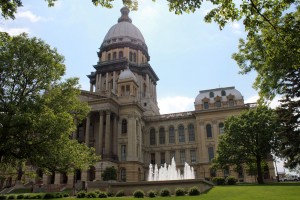Vote sought on ‘much fairer’ Illinois legislative district
Kevin Beese — July 15, 2015
The Illinois General Assembly could have a different look if the group Independent Maps is successful its crusade to have Illinois’ legislative districts drawn by a nonpartisan panel. Photo by Yinan Chen
It will take at least seven more years, but Illinois voters may eventually get state House and Senate districts that are on more level playing fields.
Members of Independent Maps, a non-partisan statewide coalition, is cheering a U.S. Supreme Court ruling in an Arizona case which said that that state’s congressional districts could be drawn by an independent panel.
Representatives of Independent Maps sees that as beneficial to their crusade to have Illinois’ legislative districts drawn by a nonpartisan panel.
“The 59 Senate seats and 104 House seats in Illinois are drawn by the party in control. (The parties) maximize whom the Legislature can elect,” said Jim Bray, spokesman for Independent Maps. “They try to draw districts against the other party.
“The districts are so out of whack and the playing field so unlevel, that in November, 60 percent of the state House and Senate candidates did not have an opponent. That is because the way the districts are drawn discourages competition. Not many people want to be a sure loser. So voters did not get a choice.”
Members of Independent Maps have just begun circulating petitions to get a statewide referendum on the ballot calling for a transparent, nonpartisan drawing of state legislative district boundaries. The group has until May to get 300,000 valid signatures filed with the state in order to get the binding question on the November 2016 ballot.
If the measure would gain voter approval, an independent panel would configure legislative districts in open sessions, not politicians carving up the districts to their benefit behind closed doors when state legislative districts are redrawn after the 2020 census.
As the proposed Independent Maps referendum only calls for revising the current way state legislative maps are drawn, it would likely take a separate referendum to stop the same gerrymandering with the drawing of congressional maps.
Democrats, who controlled the General Assembly five years ago and still do, drew the current legislative and congressional boundaries after the 2010 census.
Tim Schneider, chairman of the Illinois Republican Party, said the current system does not benefit residents of Illinois.
“I believe gerrymandering creates an environment where representatives choose who their voters are and not the other way around,” Schneider said. “I think we need something much fairer than the current system that is practiced.”
Schneider said there is much to consider when drawing districts, citing minority populations and cultural differences that must be taken into account.
He said regardless of which party controls the state Legislature after the next census, districts need to be drawn more fairly, not automatically giving certain representative certain areas.
“My belief is in fairness and equity for the people who vote,” Schneider said. “Democrats reaped the benefits this time. We should be looking at fairness for the people and moving toward fair, nonpartisan elections.”
Representatives of the Democratic Party of Illinois failed to respond to requests for comment.
Independent Map’s redistricting amendment effort in 2014 was suspended last summer when Cook County Circuit Court Judge Mary L. Mikva declared the language of the proposed amendment invalid because some of it exceeded the scope of what the Illinois Constitution authorizes for citizen initiated petitions.
Brad McMillan, executive director of the Institute for Principled Leadership in Public Service at Bradley University, has been involved in the Independent Map effort for the past six years. He said this campaign is shaping up to be the group’s best yet.
“I am excited and encouraged by the community organization this time,” McMillan said. “We have vetted the concerns for getting the number of signatures and getting the constitutional amendment on the ballot,” McMillan said. “… I hope we get the question on the ballot statewide. We need the drawing of legislative districts to be transparent.”
McMillan pointed to the successful independent drawing of state legislative districts that took place in California after the 2010 census. He noted of California’s 100 House and Senate seats that were up for election in 2012, 46 were won by new people. In contrast, McMillan said, 97.9 percent of Illinois House and Senate incumbents retained their seats in that same election year.
He noted the proposed 11-member Illinois panel that would draw the districts would consist of four Democrats, four Republicans and three independents.
“I think it is a good (proposed) system,” McMillan said.
Individuals interested in circulating petitions to get the Independent Map referendum on the ballot can go to www.mapamendment.org/VOLUNTEER-TOOLKIT.html
— Vote sought on ‘much fairer’ Illinois legislative district —








